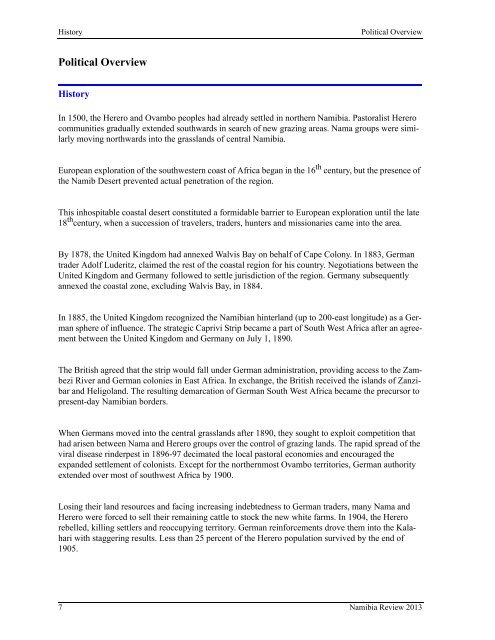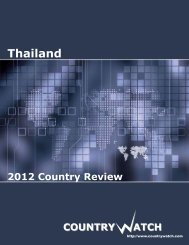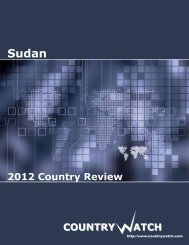- Page 1 and 2: Namibia 2013 Country Review http://
- Page 3: CountryWatch COUNTRYWATCH REVIEW 20
- Page 6 and 7: Review Trade and the Exchange Rate
- Page 8 and 9: 4 Review
- Page 10 and 11: Country Overview Country Overview C
- Page 12 and 13: Key Data Country Overview Religions
- Page 14 and 15: Key Data Country Overview Africa Re
- Page 18 and 19: History Political Overview South Af
- Page 20 and 21: Political Conditions Political Over
- Page 22 and 23: Political Conditions Political Over
- Page 24 and 25: Political Conditions Political Over
- Page 26 and 27: Political Conditions Political Over
- Page 28 and 29: Political Conditions Political Over
- Page 30 and 31: Political Risk Index Political Over
- Page 32 and 33: Political Risk Index Political Over
- Page 34 and 35: Political Risk Index Political Over
- Page 36 and 37: Political Risk Index Political Over
- Page 38 and 39: Political Stability Political Overv
- Page 40 and 41: Political Stability Political Overv
- Page 42 and 43: Political Stability Political Overv
- Page 44 and 45: Political Stability Political Overv
- Page 46 and 47: Political Stability Political Overv
- Page 48 and 49: Freedom Rankings Political Overview
- Page 50 and 51: Freedom Rankings Political Overview
- Page 52 and 53: Freedom Rankings Political Overview
- Page 54 and 55: Freedom Rankings Political Overview
- Page 56 and 57: Human Rights Political Overview con
- Page 58 and 59: Government Structure Political Over
- Page 60 and 61: Government Structure Political Over
- Page 62 and 63: Principal Government Officials Poli
- Page 64 and 65: Leader Biography Political Overview
- Page 66 and 67:
Foreign Relations Political Overvie
- Page 68 and 69:
Foreign Relations Political Overvie
- Page 70 and 71:
National Security Political Overvie
- Page 72 and 73:
Defense Forces Political Overview
- Page 74 and 75:
Defense Forces Political Overview 6
- Page 76 and 77:
Economic Overview Economic Overview
- Page 78 and 79:
Real GDP and GDP Per Capita Economi
- Page 80 and 81:
Trade and the Exchange Rate Economi
- Page 82 and 83:
Energy Consumption and Production Q
- Page 84 and 85:
Agriculture Consumption and Product
- Page 86 and 87:
Metals Consumption and Production E
- Page 88 and 89:
World Metals Pricing Summary Econom
- Page 90 and 91:
Foreign Investment Climate Investme
- Page 92 and 93:
Foreign Investment Index Investment
- Page 94 and 95:
Foreign Investment Index Investment
- Page 96 and 97:
Foreign Investment Index Investment
- Page 98 and 99:
Foreign Investment Index Investment
- Page 100 and 101:
Corruption Perceptions Index Invest
- Page 102 and 103:
Corruption Perceptions Index Invest
- Page 104 and 105:
Corruption Perceptions Index Invest
- Page 106 and 107:
Corruption Perceptions Index Invest
- Page 108 and 109:
Competitiveness Ranking Investment
- Page 110 and 111:
Competitiveness Ranking Investment
- Page 112 and 113:
Competitiveness Ranking Investment
- Page 114 and 115:
Taxation Investment Overview Method
- Page 116 and 117:
Partner Links Investment Overview I
- Page 118 and 119:
Partner Links Investment Overview E
- Page 120 and 121:
Partner Links Investment Overview A
- Page 122 and 123:
Partner Links Investment Overview T
- Page 124 and 125:
Partner Links Investment Overview C
- Page 126 and 127:
People Social Overview Social Overv
- Page 128 and 129:
Human Development Index Social Over
- Page 130 and 131:
Human Development Index Social Over
- Page 132 and 133:
Life Satisfaction Index Social Over
- Page 134 and 135:
Life Satisfaction Index Social Over
- Page 136 and 137:
Life Satisfaction Index Social Over
- Page 138 and 139:
Life Satisfaction Index Social Over
- Page 140 and 141:
Happy Planet Index Social Overview
- Page 142 and 143:
Happy Planet Index Social Overview
- Page 144 and 145:
Happy Planet Index Social Overview
- Page 146 and 147:
Status of Women Social Overview Sou
- Page 148 and 149:
Global Gender Gap Index Social Over
- Page 150 and 151:
Global Gender Gap Index Social Over
- Page 152 and 153:
Global Gender Gap Index Social Over
- Page 154 and 155:
Global Gender Gap Index Social Over
- Page 156 and 157:
Global Gender Gap Index Social Over
- Page 158 and 159:
Culture and Arts Social Overview :
- Page 160 and 161:
Travel Information Social Overview
- Page 162 and 163:
Travel Information Social Overview
- Page 164 and 165:
Travel Information Social Overview
- Page 166 and 167:
Travel Information Social Overview
- Page 168 and 169:
Travel Information Social Overview
- Page 170 and 171:
Travel Information Social Overview
- Page 172 and 173:
Travel Information Social Overview
- Page 174 and 175:
Diseases/Health Data Social Overvie
- Page 176 and 177:
Diseases/Health Data Social Overvie
- Page 178 and 179:
Diseases/Health Data Social Overvie
- Page 180 and 181:
Environmental Issues Environmental
- Page 182 and 183:
Greenhouse Gas Ranking Environmenta
- Page 184 and 185:
Greenhouse Gas Ranking Environmenta
- Page 186 and 187:
Greenhouse Gas Ranking Environmenta
- Page 188 and 189:
Greenhouse Gas Ranking Environmenta
- Page 190 and 191:
Global Environmental Snapshot Envir
- Page 192 and 193:
Global Environmental Snapshot Envir
- Page 194 and 195:
Global Environmental Snapshot Envir
- Page 196 and 197:
Global Environmental Snapshot Envir
- Page 198 and 199:
Global Environmental Snapshot Envir
- Page 200 and 201:
Global Environmental Snapshot Envir
- Page 202 and 203:
Global Environmental Concepts Envir
- Page 204 and 205:
Global Environmental Concepts Envir
- Page 206 and 207:
Global Environmental Concepts Envir
- Page 208 and 209:
Global Environmental Concepts Envir
- Page 210 and 211:
Global Environmental Concepts Envir
- Page 212 and 213:
Global Environmental Concepts Envir
- Page 214 and 215:
Global Environmental Concepts Envir
- Page 216 and 217:
Global Environmental Concepts Envir
- Page 218 and 219:
Global Environmental Concepts Envir
- Page 220 and 221:
International Environmental Agreeme
- Page 222 and 223:
International Environmental Agreeme
- Page 224 and 225:
International Environmental Agreeme
- Page 226 and 227:
International Environmental Agreeme
- Page 228 and 229:
International Environmental Agreeme
- Page 230 and 231:
International Environmental Agreeme
- Page 232 and 233:
International Environmental Agreeme
- Page 234 and 235:
International Environmental Agreeme
- Page 236 and 237:
Bibliography Appendices Appendices
- Page 238 and 239:
Bibliography Appendices Foreign Gov
- Page 240 and 241:
Bibliography Appendices BP Statisti
- Page 242 and 243:
Bibliography Appendices Tonga Monac
- Page 244 and 245:
Bibliography Appendices United Stat
- Page 246 and 247:
Bibliography Appendices United Stat
- Page 248 and 249:
Bibliography Appendices USING COUNT
- Page 250 and 251:
Bibliography Appendices 241 Namibia
- Page 252:
CountryWatch CountryWatch is an inf




